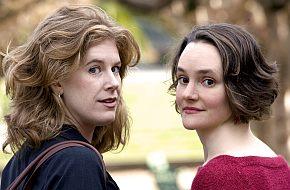ChamberBridge’s Sunday recital at Old First Church in San Francisco was a model of compositional and interpretive invention, with the San Francisco–based duo of soprano Lara Bruckmann and pianist Eva-Maria Zimmermann providing vivid performances of newly commissioned work by a mix of American and Swiss composers. The program, full of musical and technical challenges and stylistically broad, often led the performers to move beyond the expected roles of singer and pianist, and was a paragon of creative partnership between composers and performers.

Mirroring Bruckmann’s origins in the U.S. and Zimmermann’s in Switzerland, where she maintains a parallel career, the program offered music created for the duo by a mix of mostly younger Swiss and American composers, for a new-works project the duo calls “Frontiers 2010.” The afternoon began with Calling the Movers, by Jason Levis, a UC Berkeley grad student now living in Berlin (intentionally or not, the American half of the program was a bit of a showcase for UC graduate composers, with three from Berkeley and one from Davis). This is a striking and sometimes haunting work, embodying the sense of dislocation in Berlin-based writer Josepha Conrad’s text with a partly fragmented, partly lyrical approach covering a broad emotional gamut.
The “Frontiers” project also includes work by several more-established artists, one of them being the Swiss composer Christian Henking. His setting of Georg Trakl’s In einem Spiegels Bläue (In the blueing of a mirror) is a powerful neoexpressionist piece, combining atonal piano lines, as well as snapping fingers and whispers from the pianist, while the voice mixes angular lines, whispers, and shouts in capturing the dark, death-tinged text.
Two works on display took an unusual approach to spiritual texts. In his setting of Seattle poet Emily Warn’s Hand of God, the Bern-based Egyptian composer Wael Sami Elkholy created a striking opening, with a pointed piano figure met by a hushed vocal entry. The work evolves as the vocalist moves toward much whispering and gasping, as well as tapping a pair of stones. The sense of discovery is diminished, though, as the piece wears on, extending well beyond the demands of its text or its musical ideas.
Concluding the program, Sue-Hye Kim’s setting of Psalm 150, in Latin, brings extended techniques and a varied compositional language to bear in a surprising and successful way. As the text calls for praising God through sound, highly dissonant piano lines are colored by paper rustling in the piano strings, and plucked piano strings are added to the mix, while a range of vocal approaches is employed in a work of steadily increasing intensity.
For the middle section of the program, Zimmermann took the stage alone in three works for solo piano. Swiss composer Alice Baumgartner’s Ich atme Lichtstimmung ein, folge ihren Spuren was especially rewarding, revealing a rich harmonic imagination and vivid gestures spanning the entire keyboard. Berkeley composer Evelyn Ficarra’s The Arbitrariness of Language grows out of an intriguing experiment, created from a system for mapping pitches to the letters of a poem by the medieval Japanese poet Izumi Shikibu, and then expanded into a more personal work. The result is a fine piece with an idiomatic feel for the keyboard, starting with small, darting gestures, then continuing with rapid runs and developing increasingly thick textures laced with dissonant ornamental figures. The whole work holds together well, and also displays a nice sense of space.
Another Berkeley composer, Robert Yamasato, prefaced his Scherzo No. 3 with an elaborate explanation that his piece was meant to capture the literal meaning of scherzo, Italian for joke. Although he described the work as slapstick filled with failed Beethovenian pomposity, the humor in the piece is rather mild, and the interrupted gestures that mark the piece might be heard only as the motives the composer has chosen to work with. Intentions aside, and simply taken on its own terms, this is an appealing piece that reveals quite a strong musical imagination, as well as a high degree of compositional fluency.
A work that was a shift in both instrumentation and style was Marcel Sägasser’s A long moment (of pleasure) for two female voices, mixing-desk player, and tape. With Zimmermann leaving the keyboard altogether and joining Bruckmann in singing, the two performers onstage mainly produced long-held pitches that were couched in an ambient, arrestingly lovely electronic environment handled by Ficarra and Yamasato. Calling to mind the patient approach of LaMonte Young’s long-tone pieces, this was a welcome departure from the busier and more densely written works on the rest of the program.
In addition to their adventurousness and their supportive engagement with a broad range of composers, the members of ChamberBridge are each wonderful musicians who perform with a deep sense of ensemble. Bruckmann’s pitch is sure, even in the most difficult new works, and she’s capable of many vocal and emotional hues over the course of a single piece. Both the more traditional singing and the extended techniques that ran through the program were richly expressive, and she maintains a fine sound whether singing with the straight tone required at times or with a fuller voice and heavier vibrato.
And Zimmermann’s playing was both clear and powerful, shaping even the most unconventional passages with care. She also produced finely varied colors at the keyboard, and her playing is marked by a rhythmic acuity that brings life to whatever she’s playing. Many of the pieces offered a showcase for Zimmermann’s expansive musicianship, as she played the strings, snapped fingers, tapped the piano case, whistled, and spoke, along with her excellent work at the keyboard itself.

